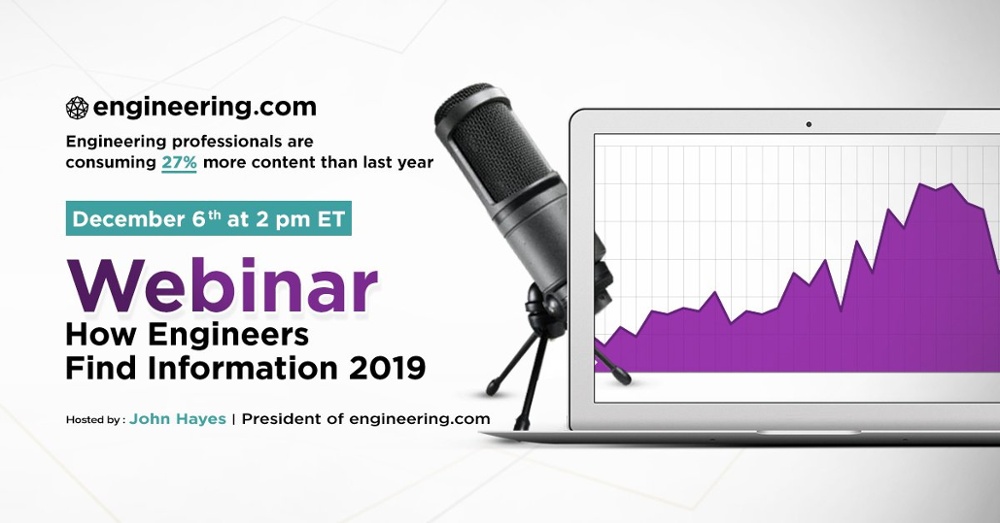It’s no secret that engineering.com runs a lot of surveys. We’ve written about it several times in this blog, and recently published a complete guide on how technology marketers can conduct similar research on their own. I’m lucky to be part of a lot of that research.
Our How Engineers Find Information study is probably my favorite. Now in its sixth year, this study takes the pulse of your prospects—the engineering.com audience. The goal is simple: help those in industrial & technology marketing to plan their marketing strategy by providing insight on what engineering professionals want.
We’ll be revealing the full findings of the study in a webinar next Thursday at 2 pm ET, so if you haven’t already, please sign up and join us.
As a preview to the webinar, today’s blog is going to reveal the three most unexpected things we learned from this year’s survey and explain what makes them so exciting.
Finding Zero: Engineers Are Consuming 24% More Content Than Last Year
This comes in at zero because it’s an insane finding that we’ve already written about—although at the time, we had 150 fewer responses and the figure was a little higher for an increase of 27%. Still, to-may-to, to-mah-to. I’m not going to rehash what we’ve already covered, but if you wanted to read about it, check out our breakdown in this blog post.
Content Consumption is Consolidating to Digital Publications
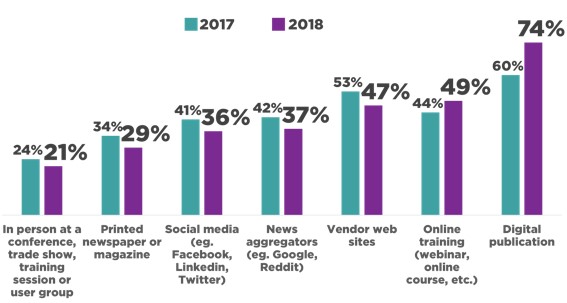
Each year we ask engineering professionals “Which, if any, of the following have you used in the last 30 days as a source of engineering information?” The results above show the data from last year’s report compared to this year’s numbers. As you can see, consumption is slightly down for 5 of the 7 platforms asked about. The two information sources that went up are online training and digital publications.
For digital publications, year-over-year, that’s a rise of 23%. That’s an incredible increase in the amount of content being consumed through digital publications this year compared to last year, especially when nearly every other source is slightly down.
So, what’s the cause of this increase? My first thought was that it very likely has to do with Google ranking results. We’ve been reporting for years (and hint, will again this year) that self-driven search is the #1 preferred means for engineers to acquire information. If you have an advantage in search, then you’ll have an advantage in being seen.
To confirm my suspicion, I dove into engineering.com’s Google Analytics to see if there was any evidence of us, a digital publication, having some kind of advantage. What I found was that compared to 2017, 2018 saw a 5% increase in organic traffic as a percentage of overall traffic. This would imply that overall, engineering.com was ranking better than it had the previous year.
This makes sense given that digital publications have an innate organic traffic advantage over other online channels such as vendor sites or social posts: digital publications have more content, longer content, and are neutral sources of information, earning them more backlinks. These all are incredibly influential inputs in determining Google’s Search Engine Result Page Rankings.
In the Key 36-65 Age Group, Vendor Sites Outperform Print Magazines & Social Media
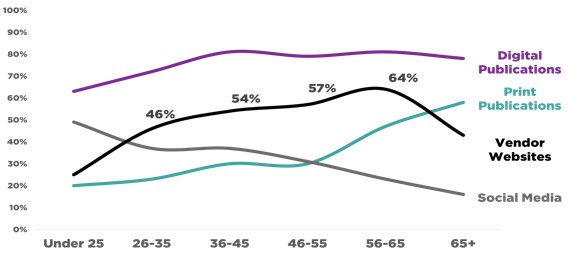
In the chart above, the values on the vertical axis show the percentage of engineers in each age group (horizontal axis) who used each information source (the colored lines) during that last 30 days.
If you haven’t noticed yet, what you’re seeing is some amazing news for every marketing department – Vendor websites (that means you, and the content you’re creating) are the second most popular information source among engineers age 36-65. That’s the golden range for decision making input, from mid career managers up to C-suite executives.
I think it’s important to highlight this finding because so often, either at meetups or conferences, I hear speakers and marketers alike focusing on generating leads from external sources and platforms. This finding really hammers home just how important developing an inbound marketing strategy is.
What does this mean for your marketing strategy next year? First, you may want to think like one of your prospects and do a little User Experience work. Ensure that all the wonderful information you have available is easy to find and navigate. You probably also have a lot of inter-related content that hasn’t been cross-linked on your site, so do a little audit of your most popular pages and get those tuned-up.
Next, if you feel like your marketing efforts are a little starved on content, try and use this data to free up some more budget for the next year. We recently replicated some really awesome research originally conducted by LinkedIn on Thought Leadership and RFPs, showing there is a direct link to pipeline and revenue, so be sure to check that out.
If you want to know what content you should be producing, make sure you don’t miss next week’s webinar. We’ve definitely have a few slides dedicated to content preferences.
Engineers Aren’t In Love With Your New-Fangled MarTech the Same Way You Are
I think I should put it out there that I am a big fan of both Account-Based Marketing (ABM) and chatbots. I think they’re both big deals – especially bots, which I believe will one day be as ubiquitous as email marketing. Imagine how surprised I was when How Engineers Find Information 2019 turned up the following results.
Engineers' Opinions of Account-Based Marketing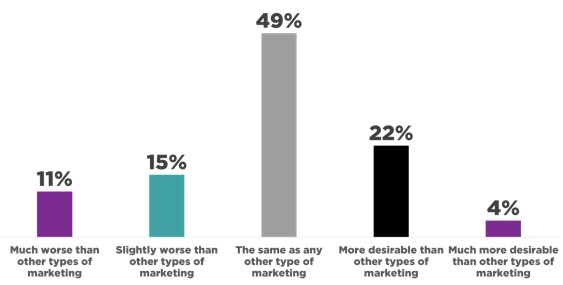
Engineers' Interactions with Chatbots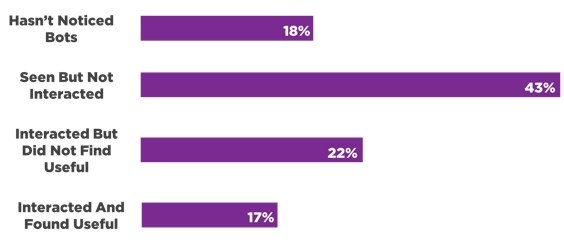
Apparently, while marketers may be in love with this new tech, engineering professionals are less enthused. However, it’s not all doom and gloom.
Assessing someone’s receptiveness to ABM is tricky, because well-done ABM doesn’t feel like you’re being marketed to—rather, you feel that you’re being helped. The personalization feels natural and friendly, like when you’re greeted by name at a hotel.
Does that mean the ABM results are meaningless? No, not at all. I think they serve as a warning. Those reported levels of ABM being “much worse” than regular marketing (nearly 3x worse than “much better”) indicate that you really want to avoid being overly personal and you don’t want your personalization to come across as insincere.
If you want some ideas on how to do ABM right, we have a blog all about it.
As for the chatbot findings, there are a couple of points I think we need to keep in mind. We’re still very early in the technology, and most marketers haven’t found their stride. The decision trees these bots use are limited, and they won’t be able to realize their full potential until they are powered by more sophisticated AI.
If you’re using bots now, these findings suggest a few things. First, try and encourage more visitors to use them. Experiment with greetings and Calls-to-Action to try and coax an interaction. Also, ensure you’re using them on appropriate pages. Don’t add a bot to a page where it will detract from your visitor’s goal. An example of this would be a page with a form to access gated content. Your visitors likely just want to access your content, and don’t want to engage with a bot at that time.
If you’re looking for prime pages to trial your bot on, I recommend first trying one on your homepage. After that, any page where a user may be looking for something would be appropriate; for example, an FAQ, product directory or content archive.
See You Next Week
We still have a ton of interesting findings to share with you during next week’s webinar, so we hope to see you there. What are you hoping we’ll answer? Let us know in the comments below and we’ll try and dig through the data to find an answer.
See you then!
-Andrew



